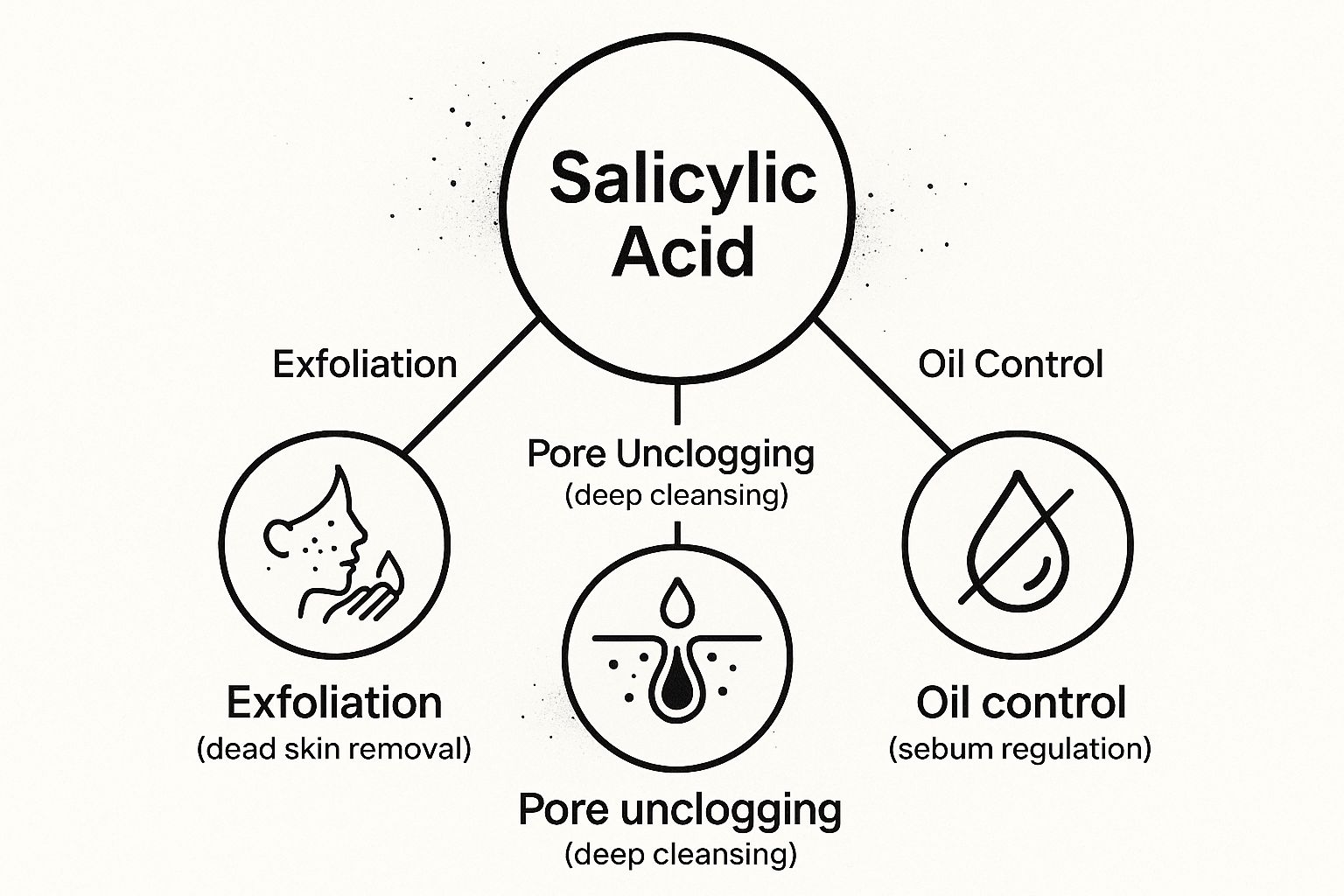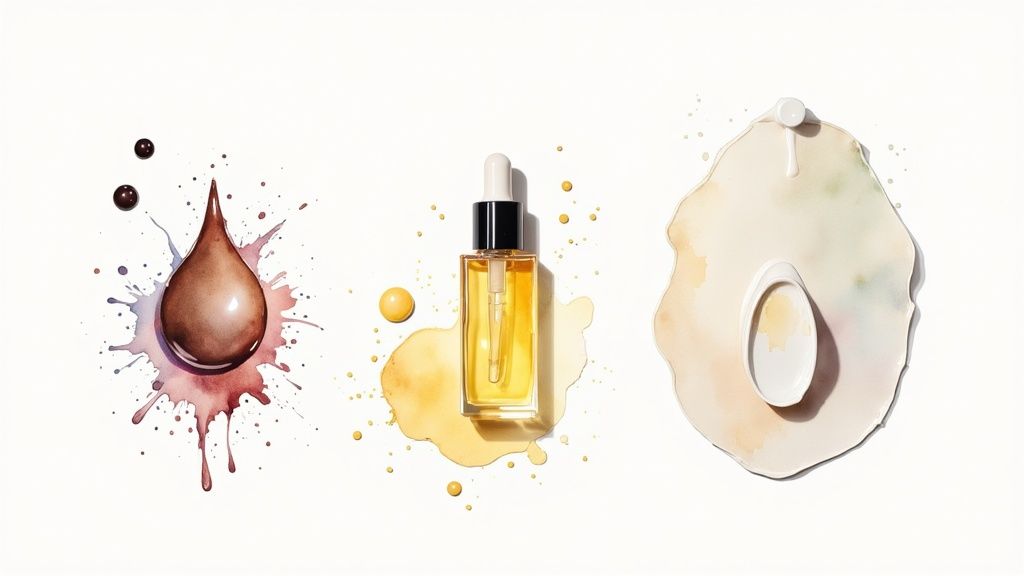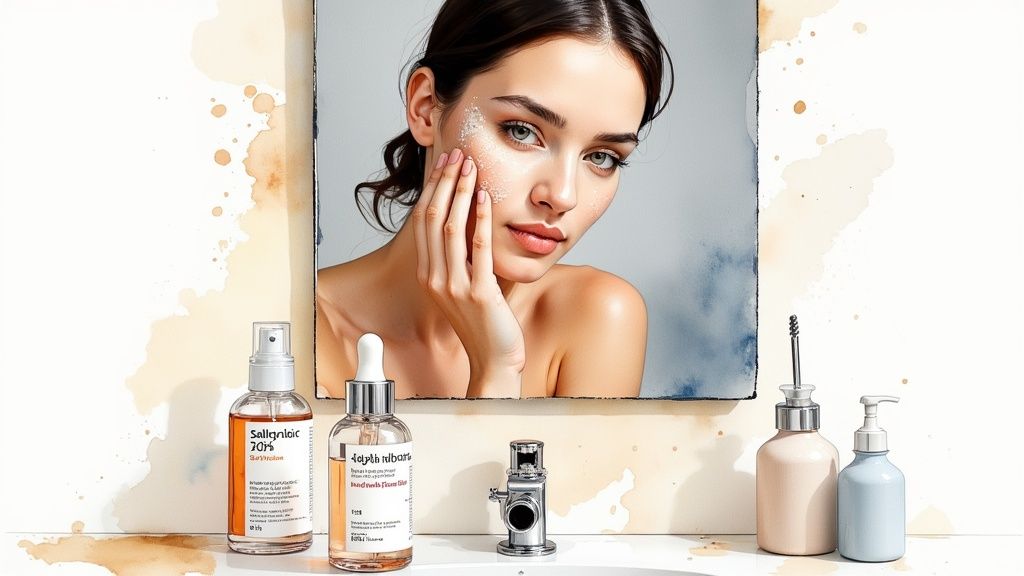
What is Salicylic Acid Used For? Benefits & Uses Explained
If you’ve ever battled stubborn breakouts, you've probably seen salicylic acid listed on a product label. It’s a superstar ingredient, known as a beta-hydroxy acid (BHA), and its main job is to exfoliate the skin and unclog pores.
What makes it so special? Unlike many other exfoliants, salicylic acid is oil-soluble. This means it can dive deep into your pores, dissolving the gunk—a mix of dead skin cells and excess oil—that causes blackheads and pimples. It's a go-to weapon in the fight against acne for a reason.
Understanding What Salicylic Acid Actually Does
Think of salicylic acid as a highly skilled cleaner for your pores. While many ingredients just work on the surface, its unique structure allows it to get past the oil and work its magic from the inside out.
This is why it's a game-changer for so many common skin issues. Its primary role is as a keratolytic agent. That’s a fancy way of saying it breaks apart the "glue" holding dead skin cells together. This action doesn't just clear out existing clogs; it also encourages healthier cell turnover, paving the way for smoother, clearer skin.
Let's quickly summarize its core uses and benefits.
Salicylic Acid At a Glance
The table below breaks down the primary jobs of salicylic acid, the results you can expect, and where you'll most often find it.
| Primary Use | Key Benefit | Common Product Forms |
|---|---|---|
| Acne Treatment | Unclogs pores and reduces breakouts | Cleansers, toners, spot treatments |
| Exfoliation | Removes dead skin cells for a smoother texture | Serums, chemical peels, body washes |
| Anti-Inflammation | Soothes redness and irritation | Calming lotions, targeted serums |
As you can see, it's a versatile ingredient that shows up in all sorts of products, from your daily face wash to more intensive treatments.
The infographic below offers a great visual summary of these key benefits.

It really comes down to three things: exfoliating the surface, clearing out the gunk, and keeping oil in check. This makes it a true multi-tasker for anyone with blemish-prone skin.
Why Is It So Popular?
There's no denying the massive demand for skincare that delivers real results, and salicylic acid is right at the heart of it. The global market for salicylic acid was valued at USD 511.34 million and is expected to hit USD 863.45 million by 2035.
A huge driver of this growth is its role in treating widespread conditions like acne, which impacts nearly 9.4% of people worldwide. You can discover more market insights from Future Market Insights to see just how significant this ingredient is.
In essence, salicylic acid addresses the root causes of many complexion issues—excess oil, clogged pores, and cellular buildup. It doesn't just manage symptoms; it helps correct the underlying problems that lead to them.
How Salicylic Acid Unclogs Pores

To really get what salicylic acid does, think of your pores like tiny straws. Day in and day out, they can get jammed with a stubborn mix of dead skin cells and your skin’s natural oil, called sebum. While a regular face wash might clean the surface, it can’t really get down into the straw to clear out the gunk.
This is where salicylic acid’s unique chemistry comes into play. It's a beta-hydroxy acid (BHA), which means it’s oil-soluble. Unlike its water-loving cousins, the AHAs, salicylic acid can slip right through the oily layers of your skin and dive deep into a pore that’s full of sebum.
It’s like using a specialized drain cleaner that’s designed to dissolve grease, not just rinse it away. It goes straight to the source of the blockage and starts to break it apart from the inside out.
Putting Its Exfoliating Power to Work
Once it’s inside the pore, salicylic acid gets down to its main job as a keratolytic agent. That’s a technical-sounding term, but it simply means it has the ability to break down keratin—a protein that acts like a sticky glue holding all those dead skin cells together.
By dissolving this "glue" between cells, it loosens the entire compacted mess, allowing it to be washed away easily. This little bit of chemical magic delivers two huge benefits for your skin.
- It clears out existing clogs. Salicylic acid dissolves the hardened buildup that creates blackheads and whiteheads, helping your current breakouts clear up much faster.
- It prevents new clogs from forming. By keeping the lining of the pore exfoliated, it stops dead cells from getting a chance to pile up in the first place.
This one-two punch is what makes salicylic acid such a hero ingredient. It’s not just a spot treatment; it’s a long-term strategy for keeping your pores clear. If you want to dive deeper into this, you can learn more about what causes clogged pores in our detailed guide.
Calming Down Redness and Irritation
Beyond its incredible exfoliating skills, salicylic acid also has some impressive anti-inflammatory properties. This is a huge deal, because let's face it—clogged pores and acne usually come with a side of angry redness and swelling.
Did you know salicylic acid is derived from willow bark? It’s the same natural source that gave us aspirin. This family connection gives it a built-in ability to soothe the skin, helping to calm down the visible inflammation that makes pimples look so angry and feel so tender.
This calming action works right alongside its pore-clearing power. So while it’s busy dissolving the blockage, it’s also telling your skin to chill out, leading to a complexion that’s not just clearer, but also much calmer and more even-toned. It’s a complete approach to tackling breakouts from every angle.
The Top Skincare Uses for Salicylic Acid

So, we've covered the science behind how salicylic acid works its deep-cleaning magic. Now, let's get into the good stuff: what can it actually do for your skin? This ingredient is far from a one-trick pony. It’s a versatile powerhouse for tackling some of the most common and frustrating complexion issues, all because it gets to work deep inside the pore, not just on the surface.
From those stubborn blackheads that won't budge to angry red pimples, salicylic acid goes straight to the source. Think of it as a tiny plumber for your pores, dissolving the gunk and grime to clear up existing breakouts and stop new ones in their tracks.
Conquering Acne and Breakouts
For anyone who’s ever battled acne, salicylic acid is a genuine game-changer. Its main job is to target what actually causes a breakout, rather than just masking the pimple you see in the mirror.
This is why it’s so effective against different kinds of acne:
- Blackheads and Whiteheads: These are essentially just clogged pores. Salicylic acid gets in there and dissolves that sticky mix of oil and dead skin, clearing them out beautifully.
- Inflamed Pimples: Thanks to its well-known anti-inflammatory abilities, it helps calm the redness and swelling that make pimples (like papules and pustules) so painful and obvious.
This one-two punch of clearing blockages while soothing irritation is what makes it an absolute must-have in any anti-acne routine. It’s no surprise that the cosmetics industry is a huge driver of the salicylic acid market. Brands value its keratolytic effects, which help shed dead skin and reduce blemishes. A great example is La Roche-Posay's Efflaclar Serum, which uses 1.5% salicylic acid to tackle acne, pores, and texture all at once. If you're curious, you can discover more about the salicylic acid market's growth and see just how in-demand this ingredient is.
Refining Skin Texture and Pore Size
Fighting acne is its star role, but salicylic acid is also incredible for improving your skin's overall texture. If you're dealing with rough patches, bumpy skin, or pores that look larger than you’d like, the culprit is often a build-up of dead skin cells and trapped oil.
Because salicylic acid is a master at dissolving that "glue" holding dead cells together, it acts as a chemical exfoliant. It gently buffs away the dull, rough top layer of your skin.
This gentle resurfacing is what reveals the smoother, softer skin hiding underneath. With consistent use, it keeps pores clean, which prevents them from getting stretched out and appearing larger.
The end result is a complexion that looks and feels much more refined and even. Your skin doesn't just look clearer—it feels silky smooth.
Managing Excess Oil and Shine
Always fighting a shiny T-zone by midday? Salicylic acid can be your secret weapon for getting that oil under control. Since it’s oil-soluble, it has a special talent for diving into greasy pores and helping to balance things out from the inside.
It won't completely shut down your skin's oil production—after all, a certain amount of oil is healthy and necessary. What it will do is help manage the excess that leads to that slick look and, ultimately, more clogs. By keeping that extra sebum in check, it helps you maintain a more matte, balanced complexion all day long. This makes it a fantastic choice for anyone with oily or combination skin.
Getting Started with Salicylic Acid in Your Routine

So, you're ready to bring this powerhouse ingredient into your skincare lineup? Fantastic. Getting started is actually pretty straightforward once you know the basic ground rules. The most important thing is to have a plan that respects your skin’s unique needs, ensuring you get all those amazing blemish-fighting benefits without any unwanted irritation.
The golden rule here is to start low and go slow. Think of it like trying a new workout—you wouldn't jump straight to the heaviest weights on your first day. The same logic applies to your skin. Begin with a lower concentration and use it just a few times a week to see how your skin feels.
Finding the Right Product and Strength
Salicylic acid isn't a one-size-fits-all ingredient. It comes in everything from daily cleansers and toners to powerful serums and spot treatments. Over-the-counter products typically range in concentration from 0.5% to 2%. Which one you pick really depends on your skin's tolerance and what you're trying to achieve.
- For Beginners or Sensitive Skin (0.5% - 1%): A gentle cleanser or a mild toner with a lower concentration is a great way to ease in. These are formulated for more frequent use and are perfect for keeping pores clear without being too aggressive.
- For Stubborn Breakouts or Oily Skin (2%): If you're dealing with persistent acne, a serum or spot treatment with a 2% concentration will give you more targeted, powerful action. These are best used less often, maybe just a few nights a week, applied directly to breakout-prone areas.
Before you go all-in, always, always do a patch test. This is non-negotiable for any new active ingredient.
How to Patch Test: Apply a small dab of the product to a discreet spot, like behind your ear or on your inner arm. Wait a full 24 hours and check for any redness, itching, or irritation.
This simple step can save you from a world of trouble and is a fundamental part of learning how to build a skincare routine that genuinely supports your skin.
To make things even clearer, here’s a quick guide to the different types of salicylic acid products and how they fit into your routine.
Salicylic Acid Products and When to Use Them
| Product Type | Typical Concentration | Best For | How to Use |
|---|---|---|---|
| Cleanser | 0.5% - 2% | Daily maintenance, mild acne, oily skin | Use once daily (usually at night) as the first step in your routine. |
| Toner | 0.5% - 2% | Post-cleansing exfoliation, clogged pores | Apply after cleansing with a cotton pad, 2-3 times per week. |
| Serum | 1% - 2% | Targeted treatment for persistent breakouts | Apply a thin layer after toning but before moisturizing, a few nights a week. |
| Spot Treatment | Up to 2% | Individual pimples | Dab a tiny amount directly onto a blemish as the last step of your routine. |
This table should help you pinpoint exactly what kind of product will work best for you. Whether you need daily maintenance or a targeted fix, there’s a salicylic acid option out there.
The Two Cardinal Rules of Using BHAs
Once you've picked your product and passed the patch test, there are two crucial rules you absolutely must follow to keep your skin barrier healthy and happy. Skipping these can lead to dryness, irritation, and sun damage, which completely defeats the purpose of using salicylic acid in the first place.
First, always follow up with a good moisturizer. Remember, salicylic acid is an exfoliant. Its oil-dissolving nature can be a bit drying, so applying a hydrator right after helps replenish moisture, balance your skin, and strengthen its natural defenses.
Second, and this is the big one: you must wear sunscreen every single day. By sloughing off that top layer of dead skin, salicylic acid reveals fresh, new skin cells underneath. While that’s great, it also means your skin is more vulnerable to UV rays. Applying a broad-spectrum sunscreen with at least SPF 30 every morning isn't optional—it's essential for protecting your progress and preventing sun damage.
Potential Side Effects and Who Should Be Cautious
Salicylic acid can be a game-changer for clear skin, but let's be real—it's a potent active ingredient. It demands respect. Like any powerful tool in your skincare arsenal, it can sometimes cause a reaction, especially when your skin is just getting used to it. Knowing what's normal and when to pull back is everything.
The most common things you might notice at first are a bit of dryness, some minor flaking, or a touch of redness. This is often just your skin's way of saying, "Whoa, what's this?" as it gets used to the ramped-up exfoliation. Think of it as a brief "getting to know you" phase. These little hiccups usually fade away as your skin builds up a tolerance. A good, solid moisturizer is your best friend here—it'll help keep your skin barrier happy.
Knowing When to Hit the Brakes
Now, for some people, salicylic acid just isn't the right fit, or at least it requires a much more careful approach. Understanding if you're in this group is key to using it safely and effectively.
You’ll want to be extra cautious if you have:
- Extremely Sensitive Skin: If your skin gets angry at the mere suggestion of a new product, a strong BHA like this might be more than it can handle.
- Skin Conditions: If you're dealing with active eczema or rosacea, salicylic acid can often make the redness and irritation worse, not better.
- An Aspirin Allergy: This is a big one. Salicylic acid is a very close chemical cousin to aspirin (acetylsalicylic acid), so if you have an allergy, you need to avoid it completely.
A Special Note on Pregnancy
For anyone who is pregnant or breastfeeding, it’s also a time to be extra mindful. While a low-concentration, wash-off product is generally considered low-risk, the potential for it to be absorbed into your system is something to take seriously.
The golden rule here is to chat with your doctor before adding any new actives into your routine during this time. They can give you advice that's tailored specifically to you and your health, making sure both you and your baby are safe.
If you’re looking for more guidance on this, our in-depth guide to safe skincare during pregnancy is a great resource. Making smart, informed choices is the bedrock of any healthy skincare routine, especially during such a life-changing time. When you move forward with a little knowledge and awareness, you can get all the benefits while keeping the risks to a minimum.
Here is the rewritten section, designed to sound natural and human-written, as if from an experienced skincare expert.
Finding the Right Salicylic Acid Product for You
Alright, you've got the science down. Now comes the fun part: finding a salicylic acid product that actually fits into your daily routine and gets the job done. Here at Olive Skin Therapy, we’re all about creating straightforward solutions that deliver what they promise. Instead of getting lost in a sea of options, let's pinpoint what your skin truly needs.
Think of a good salicylic acid cleanser as your daily insurance policy against breakouts. For keeping things clear and balanced, a gentle wash is the perfect first step. Our specially designed formula uses salicylic acid to keep pores clear of gunk without that tight, stripped feeling. It's an ideal starting point if you're new to BHAs or just trying to manage that tricky combination skin.
For More Stubborn Skin Issues
But what if you're dealing with breakouts that just won't quit or blackheads that have overstayed their welcome? That's when you bring in a more targeted treatment, like a serum. A serum delivers a more potent concentration of salicylic acid right where you need it, working on a deeper level to break down those stubborn clogs and smooth out your skin's texture over time. It’s a precision tool for your skincare toolkit.
There's a reason salicylic acid is a superstar in the skincare world. The global market for it was valued at a massive USD 547.5 million, and the pharmaceutical side of things made up nearly 45% of that—mostly because it’s just so effective for acne and other common skin woes. If you're curious, you can explore more data on its market performance.
The secret to success with any active ingredient is matching the product's strength to your skin's unique needs. Whether you need a gentle daily cleanser or a more powerful spot treatment, consistency is what will give you that long-term clarity.
Our mission at Olive Skin Therapy is simple: give you the knowledge and the products to feel amazing in your own skin. We’re here to help you choose the right formula with confidence, so you can start your journey to a clearer, brighter complexion with a brand that has your back.
Got Questions About Salicylic Acid? Let's Talk.
Even after getting the basics down, you probably have a few practical questions about using salicylic acid. It's one thing to know what it does, and another to know how to fit it into your real-life routine. Let's clear up some of the most common questions so you can feel confident and safe.
A huge one I always get is about mixing active ingredients. What about using salicylic acid with something potent like retinol? The short answer is yes, you can, but you have to be smart about it.
Slathering them on at the same time is a recipe for redness and irritation. A much better strategy is to alternate. Use your salicylic acid one night, then retinol the next. This way, your skin gets all the amazing benefits of both without being pushed past its limits.
How Long Does It Really Take to See a Difference?
Skincare is a marathon, not a sprint, and salicylic acid is no different. While you might see some initial improvements in oiliness or calming of red, angry pimples within a week or two, the real magic takes a bit longer.
For those deep, stubborn blackheads and clogged pores, consistency is everything. You'll likely need to stick with it for four to six weeks before you see a major change. This gives the ingredient enough time to work its way through a few skin cycles, clearing out all that existing gunk and helping to stop new clogs from forming.
Don't be alarmed if you experience a little "purge" at first. This happens when the accelerated exfoliation pushes underlying congestion to the surface all at once, causing a temporary breakout. It looks like a bunch of small pimples popping up. This is totally different from a bad reaction, which usually involves itching, burning, or a rash.
A true purge usually happens in the areas you typically break out and should calm down within a few weeks. If the irritation hangs around or shows up in new places, stop using the product and check in with a pro.
Surprising Ways to Use Salicylic Acid (It's Not Just for Your Face)
Salicylic acid is a rockstar for facial acne, but its talents don't end there. Because it's so good at breaking down keratin—the protein that can build up and cause blockages—it’s fantastic for tackling other body skin issues.
It's a go-to ingredient for treating:
- Keratosis Pilaris: You know those tiny, rough bumps on the backs of your arms or thighs? People often call it "chicken skin," and salicylic acid can help smooth it out.
- Ingrown Hairs: By clearing away dead skin, it helps those trapped hairs break free.
- Body Acne: It’s just as effective at clearing up breakouts on your chest and back as it is on your face.
Ready to incorporate professional, results-driven treatments into your routine? At Olive Skin Therapy, we create personalized plans to help you achieve your healthiest skin ever.
